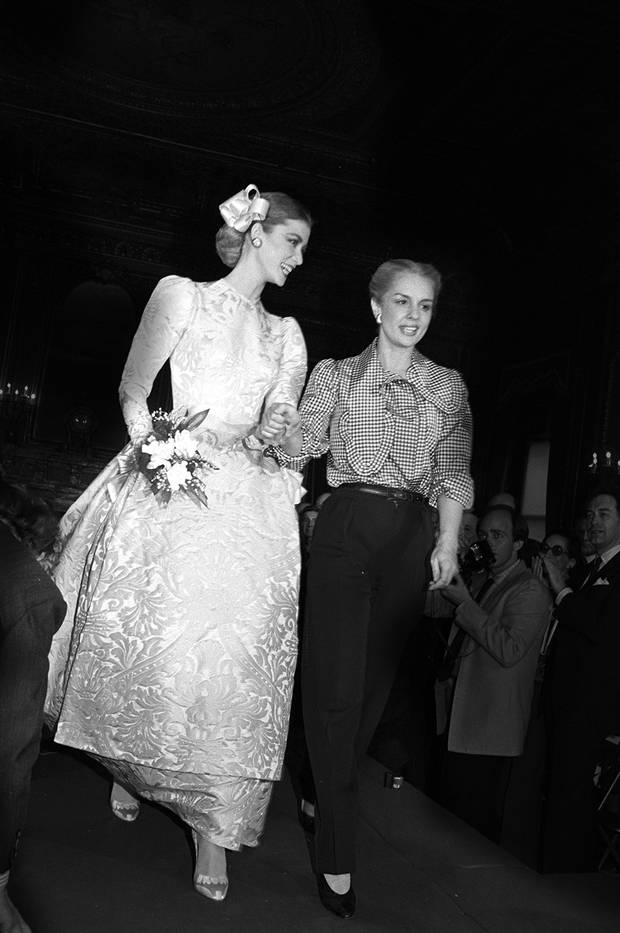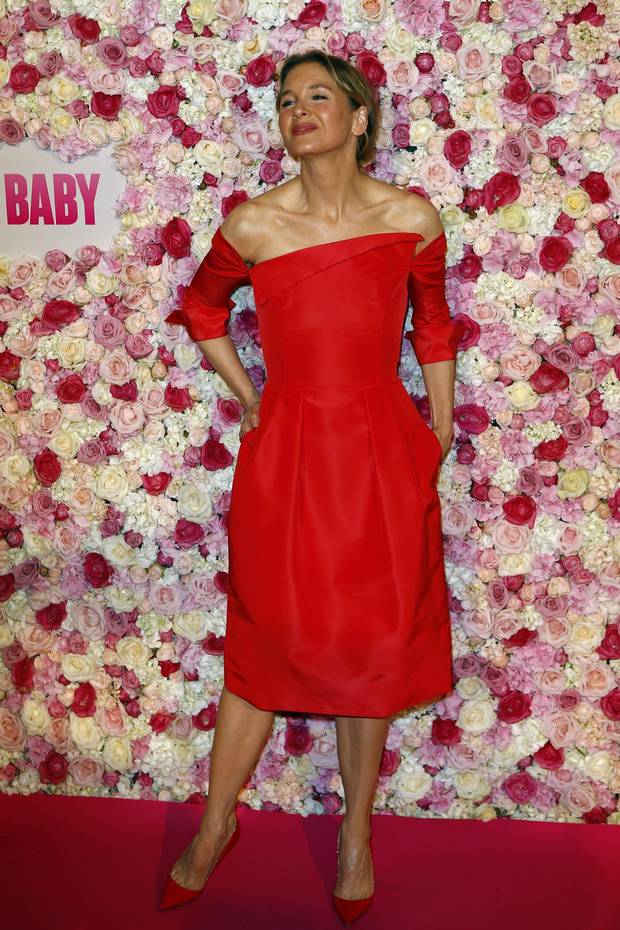'I remember meeting Carolina and her husband Reinaldo at a party in New York about 1974, and thinking they were the most elegant couple I'd ever met," says Bob Colacello, Vanity Fair's special correspondent. "They were like MGM movie stars from the 1930s, but at the same time totally cool and hip – without trying to be."
It was not Carolina Herrera's first time making a fashionable splash. While speaking to her in her sun-filled office on New York's 7 th Avenue in early August, she tells me that when she was 13 or 14 she "wanted to become a vamp like Marlene Dietrich, with a cigarette holder."
She may not have followed Dietrich into screen siren stardom, but Herrera has certainly made a glamorous mark on the world of fashion. Her entrée was different than that of many of her formally trained peers. "My family, they were all very well dressed. I didn't go to fashion school because I had fashion school at home," says the 77-year-old designer when asked about her formative years surrounded by stylish women. "I grew up with beautiful women dressed in a wonderful way."
Herrera has an accent, an aural souvenir of her birthplace, Caracas, Venezuela, but speaks with the unabashed confidence for which New Yorkers are known. And it's fitting, because Mrs. Herrera, as she is referred to around the office by her legion of stylish staff, is first and foremost an American designer. Her debut collection was shown in New York 35 years ago, and ever since, the Carolina Herrera New York collection has been made in her own atelier in the city's fashion district where designers like Bill Blass and Norman Norell got their start.

The new book Carolina Herrera: 35 Years of Fashion, released earlier this fall and published by Rizzoli, pays tribute to her storied career, and this season, her designs arrived on the racks at Holt Renfrew for the first time. Both are proof of Herrera's continued design innovation and influence.
Herrera's story is one that reads a bit like a fairy tale: Born into an affluent household with a lifestyle that revolved around tennis, horses, world travel and wildly social relatives, her brief first marriage was followed by a second union to Reinaldo Herrera Guevara.
The couple settled in the Big Apple in 1980 – the same year she made her first appearance on Vanity Fair's best-dressed list – and a few years later, at the suggestion of the high priestess of fashion, Diana Vreeland, then special consultant to the Metropolitan Museum of Art's Costume Institute, Herrera launched her line. "I went to see her because I wanted to do something with my life," Herrera says. "I said, 'I have a plan to design materials, textiles.' She said, 'Please, no, what a boring idea! Why don't you try and do a collection?'" The seed was planted and Herrera got to work. When she came back to Vreeland with her "little collection," the one-time Vogue editor gave it her stamp of approval with a succinct, "This is it, go!"
In April 1981, she presented the pieces at the Metropolitan Club on New York's Upper East Side. "I was so happy, I didn't know what I was getting into!" Herrera says with a laugh. "It was so much fun. I had live musicians playing Cole Porter songs and the whole of New York was there. It was about glamour, it was about femininity, it was about elegance and chic – everything that I still stand for."

Herrera accompanies a model on the runway during the finale of her ready-to-wear fall collection in 1981 in New York.
John Bright;Tony Palmieri
Bianca Jagger and Andy Warhol attend one of Herrera’s shows in 1981.
Bettmann/Bettmann Archive
In Carolina Herrera: 35 Years of Fashion, there is a photograph of legendary clotheshorse Nan Kempner at the show, and images of Vreeland, Andy Warhol and Bianca Jagger. "In fact, C.Z. gave a dinner for me that night at Doubles," she says referring to society stalwart C.Z. Guest, the wife of polo champion Winston Frederick Churchill Guest.
I ask what her design contemporaries in New York thought about her transition from client to competition. "Bill Blass was my great friend," she says. "I used to be dressed by him, by Oscar [de la Renta], Geoffrey Beene, Calvin Klein – all of them." She says it was Blass who helped her the most. "He showed me how many models I would have to have for the show. He gave me the names of the girls. He was a good, good friend. Halston was amazed that I wanted to become a fashion designer. He said, 'Are you sure you want to get involved in all that?' He couldn't understand it."
Over the next three-and-a-half decades, the line evolved into a favourite of both celebrities and her society peers and has transcended generations with its sophisticated aesthetic. "You never know where you are going to arrive. When you do something new in your life do you think you know where exactly you are going to end up? No!" Herrera says. "You have a vision. I didn't know there was going to be so much work involved. I didn't know that it was going to be a serious one. I thought I was going to do a collection, and come back to my house, but you have to do it all the time."
"There were those in the fashion world who doubted [Herrera's] commitment and relevance along the way, typecasting her as a high-society dilettante stitching up froufrou frocks for her fancy friends," Colacello says. "She proved them wrong, both with her huge success and the beautiful, modern clothes she creates." Herrera herself seems pleased to have proved those naysayers wrong. "Here I am, after 35 years, sitting here and talking to you," she says.
At former Vogue editor Diana Vreeland’s book launch at Mortimer’s restaurant in 1984, Herrera (second right) is pictured with Vreeland (left) and socialite Iris Love (middle).
Ron Galella/WireImage
On the morning of our conversation, the time slot in her busy calendar before our interview was blocked out for a fitting – a wedding dress for the daughter of a friend (she doesn't name names, so I didn't dare ask). The first wedding dress Herrera designed was for Caroline Kennedy, the daughter of her friend Jacqueline Kennedy Onassis, who at the time, in late 1980s, was being dressed almost exclusively by Herrera. It was that dress for Caroline's wedding to Edwin Schlossberg in 1986 that helped launch the Carolina Herrera bridal collection, which makes up a large part of her business today. "Jackie left her on her own with me to do it. She didn't interfere in anything," she says of the experience, an anecdote Herrera is keen to retell to the occasionally imperious mother of the bride.
After staging large shows at Bryant Park and Lincoln Centre during New York Fashion Week for years, Herrera recently moved her presentations uptown, showing her designs inside The Frick Collection, a gilded mansion turned museum on Fifth Avenue. "It's a beautiful way to show," she says. It's very civilized and it's all about the clothes – it's not about the spectacle." Around 200 clients, editors and buyers are invited to the show and "everyone gets front row so they don't have fights!" she says with a laugh. "Before it was 1,200 people at Bryant Park; now we get emails asking 'Why didn't you invite me?'"

Renee Zellweger wears a Carolina Herrera dress to the Paris premiere of Bridget Jones’s Baby in September.
Francois Mori/The Associated Press
Taste is ever-changing but it seems that Herrera's brand of elegance is still in demand. "For me, elegance is connected with beauty and fashion. It has always been and always will be," she says. "To make women look beautiful, that's what we want, no?"